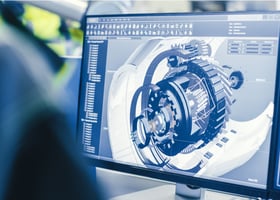Finding the right partner for large or complex precision machining projects can be challenging....
Navigating the Future: Insights on Post-COVID Automation Trends
At the early stages of the COVID pandemic in April of 2020, Joe Gemma, Chief Revenue Officer of Wauseon Machine, penned the piece below.
Revisiting now, it is evident to see the progress we have made, but there is still much to do. Obstacles such as global shortages of skilled labor, challenges with localization and last mile management with logistics, as well as many others are still present. It is encouraging and exciting to see the development and accelerated rate of progress, and a motivating reminder of the growth that can be made in a short period of time.
Early Stages of the COVID Pandemic - April 2020
While as a global population, we will learn many things from the challenge now facing us, I believe it is safe to say that we will see an acceleration in the use of automation technologies going forward, especially when it is to keep workers and consumers safe. Ironically, prior to this crisis there was still some hesitation in North America and Europe, particularly for wide spread use of robotics technology. This unprecedented situation has many companies rethinking this position, and many will now push to review opportunities to automate production and processes.
We will likely see increased investment in both traditional areas of manufacturing, like medical device production, and non-traditional areas, like recycling and fast food processes. The grocery industry will certainly undergo a change, whether it is disinfecting/sanitizing automation or inventory management. They will need to rethink and re-evaluate the current method and invest in new technological approaches to handling and storage. Asset management in general will see a paradigm shift in the control and individual allotment disbursement through automation technologies to protect the manufacturing companies and consumers of the products.
Some technology areas have already seen higher visibility due to the circumstances. For example, additive manufacturing or 3D printing emphasized the flexibility inherent in the process and brought recognition to the benefits like mass customization, localized production, simplified logistics and spare parts on demand.
While the investment in robotics and automation has seen a cost reduction in the last several years, with volumes increasing, the cost of automation is also likely to see a further decrease and see an increase in standardization. However, this will also create a boom in better paying, higher qualities jobs with new required skill sets.
Other areas that are already rapidly changing will get a boost in utilization from these events in the near future, like Artificial Intelligence and Logistics Automation. For example, AI among many things will allow for simpler review of processes and eliminate redundant inspections and Logistics will have an impact across the whole value chain, particularly in the last mile delivery development area. Mobility is a major and beneficial disruptive technology that is still underutilized but will see amplified use almost immediately. Some additional benefits of embracing automation technologies are that it is scalable, flexible and adaptable.
There are certainly some gaps, as “ease of use” is not readily available for all the technologies that are merging, and common communication tools need to be developed further. Also, we will need a deeper shift in public policy and retraining/education strategies to meet the needs of this fast-moving evolution.
This will almost certainly bring on a cultural change of acceptance in all areas of our lives, including the doctor’s office, tele-medicine, legal and financial management, among others. It is an interesting time and will have a lasting legacy on the nature of work, but it will help us prepare ourselves for the economy of the not-too-distant future.


